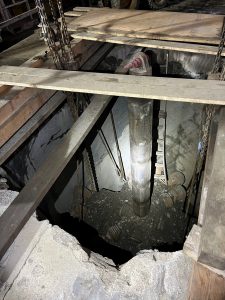New results from the MicroBooNE experiment at the U.S. Department of Energy’s Fermi National Accelerator Laboratory deal a blow to a theoretical particle known as the sterile neutrino. For more than two decades, this proposed fourth neutrino has remained a promising explanation for anomalies seen in earlier physics experiments. Finding a new particle would be a major discovery and a radical shift in our understanding of the universe.
However, four complementary analyses released by the international MicroBooNE collaboration and presented during a seminar today all show the same thing: no sign of the sterile neutrino. Instead, the results align with the Standard Model of Particle Physics, scientists’ best theory of how the universe works. The data is consistent with what the Standard Model predicts: three kinds of neutrinos—no more, no less.
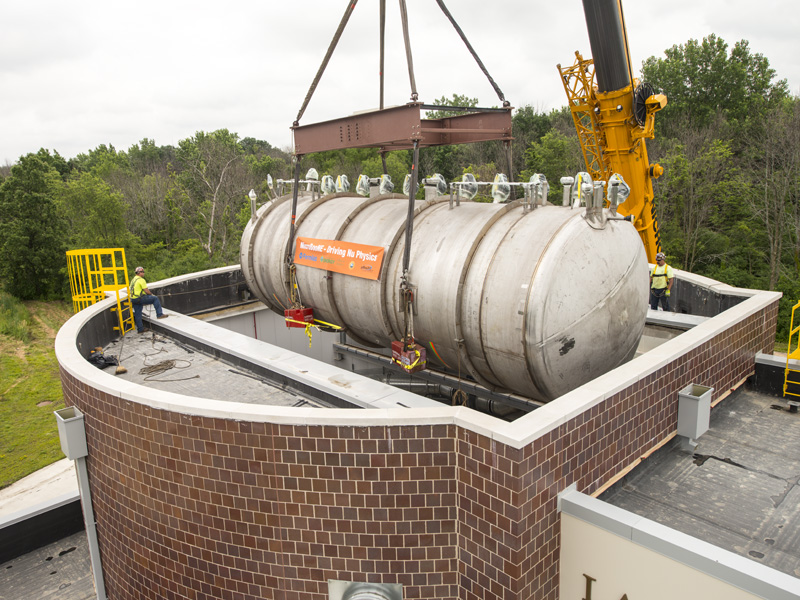
The international MicroBooNE experiment uses a 170-ton detector placed in Fermilab’s neutrino beam. The experiment studies neutrino interactions and has found no hint of a theorized fourth neutrino called the sterile neutrino. Photo: Reidar Hahn, Fermilab.
“MicroBooNE has made a very comprehensive exploration through multiple types of interactions, and multiple analysis and reconstruction techniques,” said Bonnie Fleming, physics professor at Yale University and co-spokesperson for MicroBooNE. “They all tell us the same thing, and that gives us very high confidence in our results that we are not seeing a hint of a sterile neutrino.”
MicroBooNE is a 170-ton neutrino detector roughly the size of a school bus that has operated since 2015. The international experiment has close to 200 collaborators from 36 institutions in five countries. They used cutting-edge technology to record spectacularly precise 3D images of neutrino events and examine particle interactions in detail—a much-needed probe into the subatomic world.
Neutrinos are one of the fundamental particles in nature. They’re neutral, incredibly tiny, and the most abundant particle with mass in our universe—though they rarely interact with other matter. They’re also particularly intriguing to physicists, with a number of unanswered questions surrounding them. These puzzles include why their masses are so vanishingly small and whether they are responsible for matter’s dominance over antimatter in our universe. This makes neutrinos a unique window into exploring how the universe works at the smallest scales.
MicroBooNE’s new results are an exciting turning point in neutrino research. With sterile neutrinos further disfavored as the explanation for anomalies spotted in neutrino data, scientists are investigating other possibilities. These include things as intriguing as light created by other processes during neutrino collisions or as exotic as dark matter, unexplained physics related to the Higgs boson, or other physics beyond the Standard Model.
First hints of sterile neutrinos
Neutrinos come in three known types—the electron, muon and tau neutrino—and can switch between these flavors in a particular way as they travel. This phenomenon is called “neutrino oscillation.” Scientists can use their knowledge of oscillations to predict how many neutrinos of any kind they expect to see when measuring them at various distances from their source.

MicroBooNE’s advanced liquid argon technology enables researchers to capture detailed images of particle tracks. This electron neutrino event shows an electron shower and a proton track. Image: MicroBooNE collaboration.
Neutrinos are produced by many sources, including the sun, the atmosphere, nuclear reactors and particle accelerators. Starting around two decades ago, data from two particle beam experiments threw researchers for a loop.
In the 1990s, the Liquid Scintillator Neutrino Detector experiment at DOE’s Los Alamos National Laboratory saw more particle interactions than expected. In 2002, the follow-up MiniBooNE experiment at Fermilab began gathering data to investigate the LSND result in more detail.
MiniBooNE scientists also saw more particle events than calculations predicted. These strange neutrino beam results were followed by reports of missing electron neutrinos from radioactive sources and reactor neutrino experiments.
Sterile neutrinos emerged as a popular candidate to explain these odd results. While neutrinos are already tricky to detect, the proposed sterile neutrino would be even more elusive, responding only to the force of gravity. But because neutrinos flit between the different types, a sterile neutrino could impact the way neutrinos oscillate, leaving its signature in the data.
But studying the smallest things in nature isn’t straightforward. Scientists never see neutrinos directly; instead, they see the particles that emerge when a neutrino hits an atom inside a detector.
The MiniBooNE detector had a particular limitation: It was unable to tell the difference between electrons and photons (particles of light) close to where the neutrino interacted. This ambiguity painted a muddled picture of what particles were emerging from collisions. You can think of it like having a box of chocolates—MiniBooNE could tell you it contains a dozen pieces, but MicroBooNE could tell you which ones have almonds, and which have caramel.
If MiniBooNE were truly seeing more electrons than predicted, it would indicate extra electron neutrinos causing the interactions. That would mean something unexpected was happening in the oscillations that researchers hadn’t accounted for: sterile neutrinos. But if photons were causing the excess, it would likely be a background process rather than oscillations gone wild and a new particle.
It was clear that researchers needed a more nuanced detector. In 2007, the idea for MicroBooNE was born.
MicroBooNE: precision detector
The MicroBooNE detector is built on state-of-the-art techniques and technology. It uses special light sensors and more than 8,000 painstakingly attached wires to capture particle tracks. It’s housed in a 40-foot-long cylindrical container filled with 170 tons of pure liquid argon. Neutrinos bump into the dense, transparent liquid, releasing additional particles that the electronics can record. The resulting pictures show detailed particle paths and, crucially, distinguish electrons from photons.

Workers install a component of MicroBooNE’s precision detector (called a time projection chamber) into the cylindrical container, or cryostat. Photo: Reidar Hahn, Fermilab.
MicroBooNE’s first three years of data show no excess of electrons—but they also show no excess of photons from a background process that might indicate an error in MiniBooNE’s data.
“We’re not seeing what we would have expected from a MiniBooNE-like signal, neither electrons nor the most likely of the photon suspects,” said Fermilab scientist Sam Zeller, who served as MicroBooNE co-spokesperson for eight years. “But that earlier data from MiniBooNE doesn’t lie. There’s something really interesting happening that we still need to explain.”
MicroBooNE ruled out the most likely source of photons as the cause of MiniBooNE’s excess events with 95% confidence and ruled out electrons as the sole source with greater than 99% confidence, and there is more to come.
MicroBooNE still has half of its data to analyze and more ways yet to analyze it. The granularity of the detector enables researchers to look at particular kinds of particle interactions. While the team started with the most likely causes for the MiniBooNE excess, there are additional channels to investigate—such as the appearance of an electron and positron, or different outcomes that include photons.
“Being able to look in detail at these different event outcomes is a real strength of our detector,” Zeller said. “The data is steering us away from the likely explanations and pointing toward something more complex and interesting, which is really exciting.”
While the first analyses weighed in on the sterile neutrino, additional analyses could provide more information about exotic explanations, including dark matter, axion-like particles, the hypothetical Z-prime boson and beyond. There’s even a chance it could still be a sterile neutrino, hiding in even more unexpected ways.
Future neutrino exploration
Neutrinos are surrounded by mysteries. The anomalous data seen by the earlier MiniBooNE and LSND experiments still need an explanation. So too does the very phenomenon of neutrino oscillation and the fact that neutrinos have mass, neither of which is predicted by the Standard Model. There are also tantalizing hints that neutrinos could help explain why there is so much matter in the universe, as opposed to a universe full of antimatter or nothing at all.
MicroBooNE is one of a suite of neutrino experiments searching for answers. Crucially, it’s also a long-running testbed for the liquid argon technology that will be used in upcoming detectors.
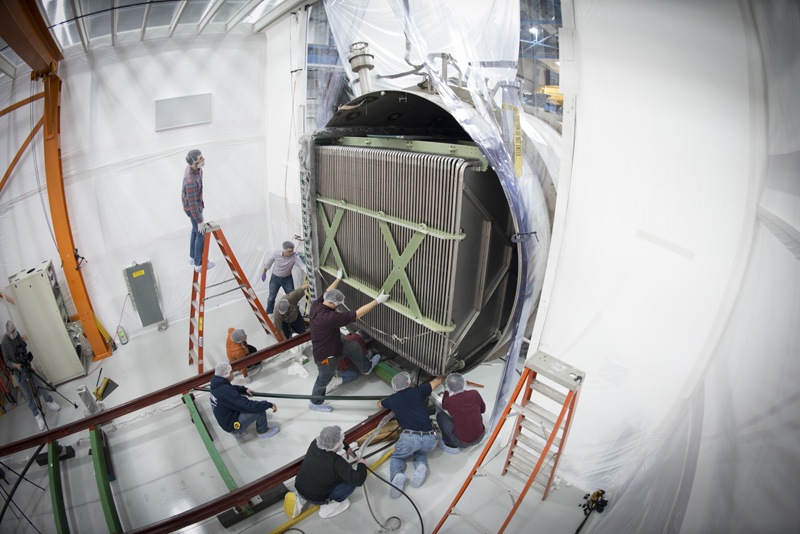
The team inserts the time-projection chamber into the MicroBooNE cryostat. Photo: Reidar Hahn, Fermilab
“We’ve built and tested the hardware, and we’ve also developed the infrastructure to process our enormous dataset,” said Justin Evans, a scientist at the University of Manchester and MicroBooNE co-spokesperson. “That includes the simulations, calibrations, reconstruction algorithms, analysis strategies and automation through techniques like machine learning. This groundwork is essential for future experiments.”
Liquid argon is the material of choice for the ICARUS detector set to begin gathering physics data soon and the Short-Baseline Near Detector coming online in 2023. Together with MicroBooNE, the three experiments form the Short-Baseline Neutrino Program at Fermilab and will produce a wealth of neutrino data. For example, in one month, SBND will record more data than MicroBooNE collected in two years. Today’s results from MicroBooNE will help guide some of the research in the trio’s broad portfolio.
“Every time we look at neutrinos, we seem to find something new or unexpected,” said Evans. “MicroBooNE’s results are taking us in a new direction, and our neutrino program is going to get to the bottom of some of these mysteries.”
Liquid argon will also be used in the Deep Underground Neutrino Experiment, a flagship international experiment hosted by Fermilab that already has more than 1,000 researchers from over 30 countries. DUNE will study oscillations by sending neutrinos 800 miles (1,300 km) through the earth to detectors at the mile-deep Sanford Underground Research Facility. The combination of short- and long-distance neutrino experiments will give researchers insights into the workings of these fundamental particles.
“We have some big, unanswered questions in physics that many experiments are trying to address,” Fleming said. “And neutrinos may be telling us where to find some of those answers. I think if you want to understand how the universe works, you have to understand neutrinos.”
More ways to engage: Visit the MicroBooNE website. Take a virtual tour inside the MicroBooNE detector. Watch the Even Bananas video series about neutrinos. Print your own “Intriguing Neutrino” poster. See additional MicroBooNE images.
MicroBooNE is supported by the U.S. Department of Energy, U.S. National Science Foundation, Swiss National Science Foundation, U.K. Science and Technology Facilities Council, U.K. Royal Society, and European Union’s Horizon 2020.
Fermi National Accelerator Laboratory is America’s premier national laboratory for particle physics research. A U.S. Department of Energy Office of Science laboratory, Fermilab is located near Chicago, Illinois, and operated under contract by the Fermi Research Alliance LLC. Visit Fermilab’s website at https://www.fnal.gov and follow us on Twitter @Fermilab.
The DOE Office of Science is the single largest supporter of basic research in the physical sciences in the United States and is working to address some of the most pressing challenges of our time. For more information, please visit science.energy.gov.
Thyssen Mining excavation crews in Lead, South Dakota, are preparing the Long-Baseline Neutrino Facility for the Deep Underground Neutrino Experiment known as DUNE, hosted by the U.S. Department of Energy’s Fermi National Accelerator Laboratory and supported by the DOE Office of Science. In a project that requires the excavation of 800,000 tons of rock, they have carefully navigated the challenge of the raise-bore drilling stage.
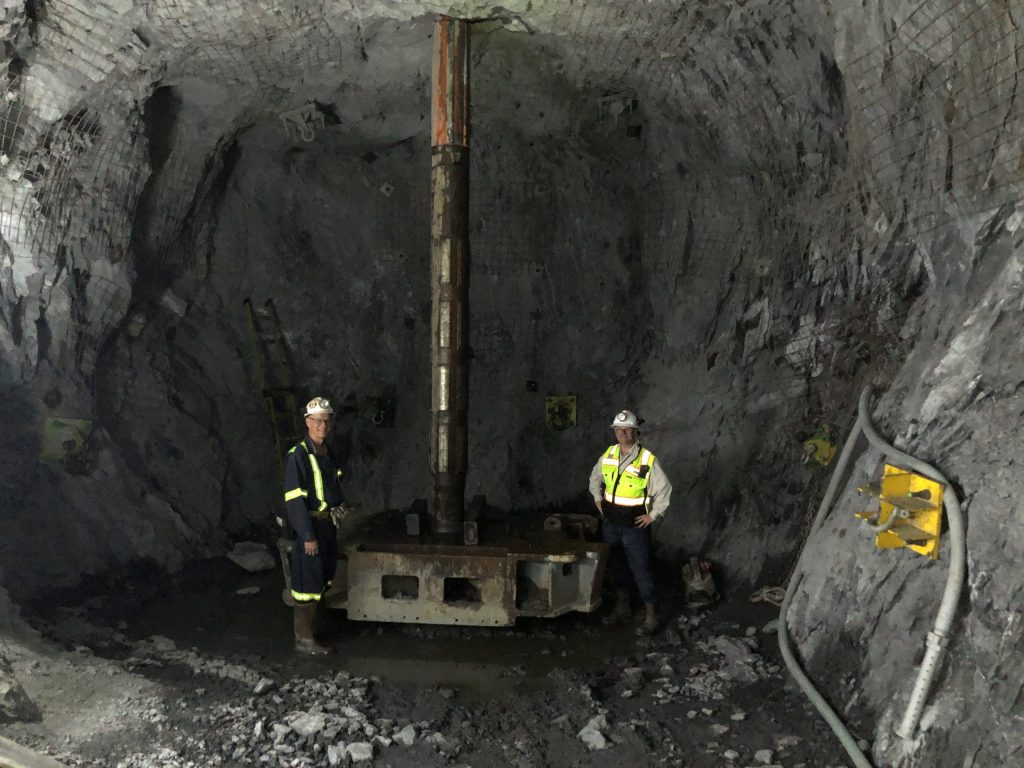
Fermilab LBNF engineers James Rickard and Syd Devries stand beside the 12-foot reamer at the 4,850-foot level, showing the enormous size of the reamer bit used to drill the ventilation shaft. Photo: Fermilab
On Oct. 4, crews achieved an important project milestone by completing the raise-bore excavation of the quarter-mile vertical ventilation shaft on schedule, paving the way for lining the circumference of the shaft with sprayed concrete.
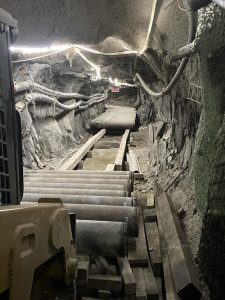
The logistics to complete this project were considerable: For example, TMI needed more than 200 segments of drill rod or string, each measuring 5 feet long, to excavate this ventilation shaft. Photo: Fermilab
Raise boring is used to create a circular vertical excavation area between an upper and lower level. For this project, the vertical ventilation shaft will first serve as the opening to improve the flow of air needed for excavation. Later, nearly a mile underground at the 4,850-foot level, where the main construction work will take place, it will provide future cooling for the LBNF/DUNE experiment.
Starting in June, a 1,200-foot-long pilot hole slightly more than a foot (13”) in diameter was drilled from the 3,650-foot level down to the 4,850-foot level to prepare the area for the raise bore. A massive 12-foot reaming bit made of tungsten carbide with a steel frame, attached to steel rods called drill string, was then employed and slowly pulled back to ream to the full size of the raise-bore shaft.
James Rickard, the Fermilab resident engineer supervising the LBNF excavation, said he has performed raise boring previously for other projects at 300 feet, but alignment of the pilot hole for a 1,200-foot job was considered one of the biggest risks of the LBNF project. Using a high-quality, German-made directional bit for the pilot drilling helped to mitigate the risk.
During the entire four-and-a-half-month process, only one reaming bit was used to chomp away at 1,200 feet of earth from early summer until its completion. Typically, each reamer is good for approximately 700 feet of drilling, and then a complete cutter change to replace it would cost to the tune of a couple hundred thousand dollars.
The excavation of the ventilation shaft finished safely and on schedule with one reamer.
Using the same reamer for the entire process without having to replace it once was not only an incredible feat for a 1,200-foot vertical drilling project, but it also revealed a geological treasure.
Much to the surprise of the crew, the reamer’s sensors detected that it struck an anomaly, which dropped 300 feet to the newly dug ground. It was found to be a large chunk of quartz crystal that measured 1 1/2 feet thick. Encountering a vein of quartz crystal isn’t overly rare during this process, but the quartz samples typically are damaged by it. This unexpected treasure, the largest Rickard has found to-date, was not damaged by the reamer head, nor by the 300-foot fall it sustained, marking it a gem of the milestone.
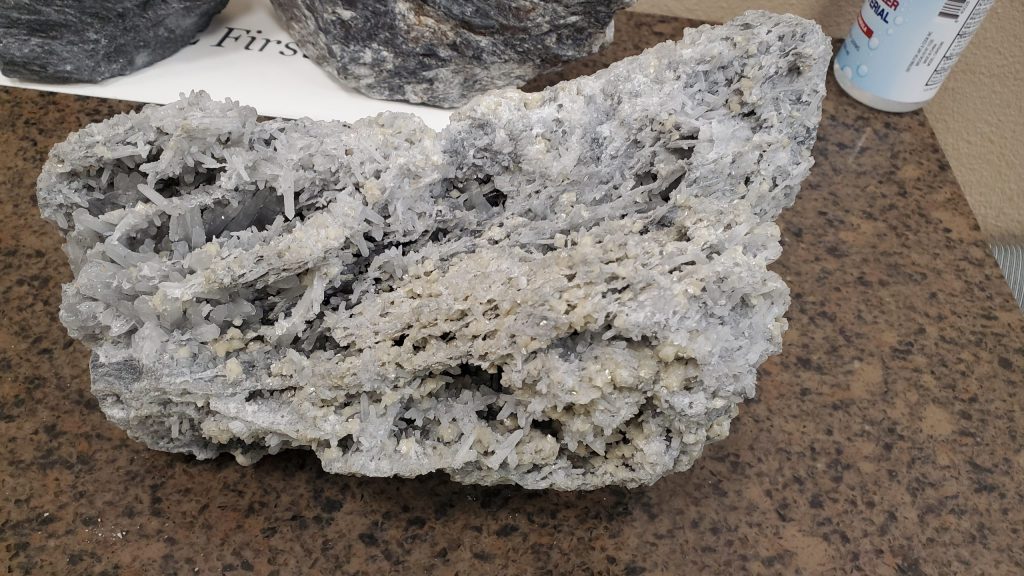
Surprise! A quartz crystal vein was intercepted at the 4,550-foot level. The crews were amazed the quartz crystals were not destroyed by the reamer’s cutting wheels. Photo: James Rickard, Fermilab
With the raise-bore process complete, the newly carved out area now needs to be washed and inspected so its surface can take the 4-inch layer of sprayed concrete coating that will line the ventilation shaft walls. Using 800 super sacks of dry shotcrete mix, with each bag weighing two tons, construction crews combine the shotcrete with water. The mixture is then transported down the raise in a pipeline with compressed air to robotically spray the concrete, slowly lining the circumference in layers from bottom to top.
While the concrete spray is underway, crews have started removing all the underground equipment used in the raise-bore process, disassembling each machine into individual components that will return to the surface.
Lining the ventilation shaft and transporting equipment components to the surface will take six weeks, and this project should be wrapped up by the end of December, a timeline, Rickard said, “is the best Christmas present!”
Fermi National Accelerator Laboratory is supported by the Office of Science of the U.S. Department of Energy. The Office of Science is the single largest supporter of basic research in the physical sciences in the United States and is working to address some of the most pressing challenges of our time. For more information, please visit science.energy.gov.

Physicist Olivier Napoly works as a guest scientist at Fermilab, helping to build the PIP-II particle accelerator. Photo: Olivier Napoly
What do you do at the U.S. Department of Energy’s Fermi National Accelerator Laboratory?
My primary responsibility is to contribute to the design, construction and testing of the PIP-II HB650 prototype cryomodule.
What is your favorite aspect of working on the PIP-II accelerator?
Building an accelerator is always a privileged experience. In addition, PIP-II is using an empowering new technology, that is superconducting radio-frequency — that, of course, is even more rewarding. But the primary interest is building a new machine for scientific research.
How many accelerator and collider projects have you worked with?
I started on a project in France at CEA-Saclay that was not built. If built, it would have been similar to the Continuous Electron Beam Accelerator Facility machine at Jefferson Lab, that is an accelerator for nuclear physics based on superconducting radio-frequency technology.
Later, I went to CERN to work on the Compact Linear Collider. Then, back at Saclay, I worked on the Tesla Linear Collider, which was also an attempt to do the e+ e– high-energy collider with major laboratories like Fermilab and DESY, which was to become the International Linear Collider.
I then worked on the European XFEL, an accelerator that was actually built by a consortium of European laboratories between 2007 and 2016. It is really the first for which I can claim some contribution to its construction.
Then came the LCLS-II project during my first term as a guest scientist at Fermilab, and so that’s No. 5.
No. 6 is PIP-II.
What does a day of work look like for you at Fermilab?
When you are a designer, you work in front of your computer, and you try to design beam transport lines from realistic accelerator components. You try to calculate the transport of the beam inside those transport lines including cavities and magnets. So, this is purely theory, purely theoretical accelerator physics.
When you are in the process of assembly, then everyday life is checking concrete problems, trying to solve as many of them as possible, and as fast as possible. For the European XFEL, this was done by establishing discussions with German colleagues at DESY and my own team at CEA-Saclay.
For 10 years, it’s being on the ground and solving a multitude of technical problems, interfaces with industry, schedule problems, budgetary problems, checking budgets and staffing requests with my own management.
But the most rewarding aspect is that it is like being part of a science orchestra where coordination, dedication and expertise are mandatory, somewhat similar to many “big science” projects.
How did you end up at Fermilab?
First, I had the opportunity to visit Fermilab many times in the past working on superconducting RF accelerators similar to the Tesla Collider, the International Linear Collider project. But these were visits for workshops or conferences. So, the reason for my presence now is working as a guest scientist.
What do you like to do when you are not at work?
I read, I walk and I try to practice some music at my level.
But I am trying to play piano — not at a high level. I listen a lot to classical music, occidental classical music, but also to Asian or African traditional music.
The Fermilab PIP-II project is supported by the DOE Office of Science.
Fermi National Accelerator Laboratory is supported by the Office of Science of the U.S. Department of Energy. The Office of Science is the single largest supporter of basic research in the physical sciences in the United States and is working to address some of the most pressing challenges of our time. For more information, please visit science.energy.gov.
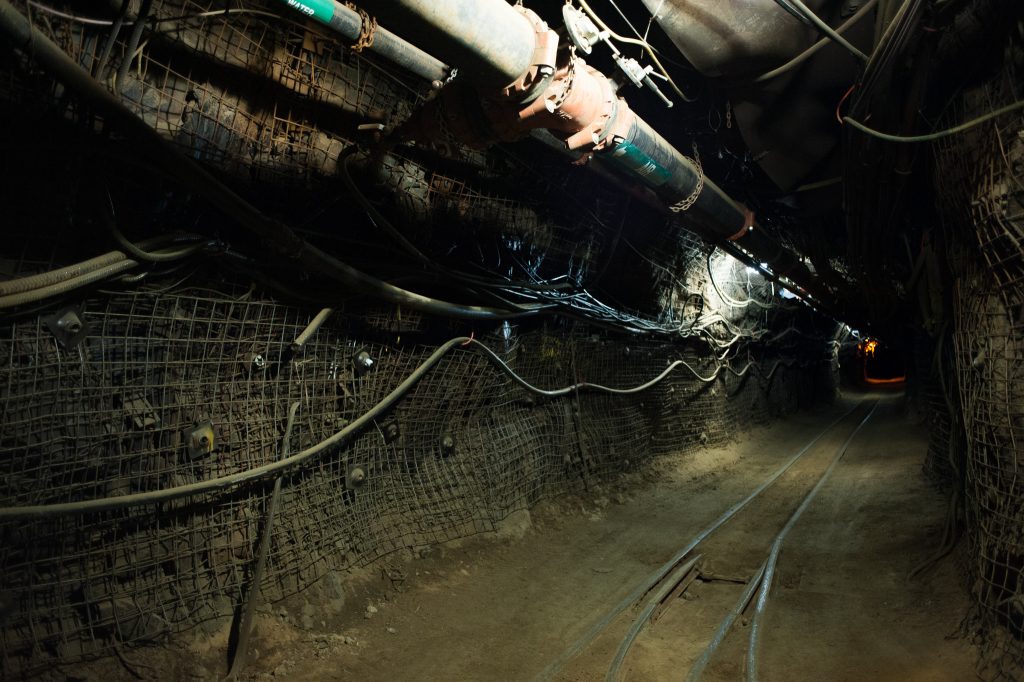
To get to SNOLAB’s cleanroom, where the SENSEI experiment is to be housed, a trip more than a mile underground inside a working mine, pictured here, is required. Photo: SNOLAB
In the search for dark matter particles, a tabletop experiment in the heart of a Canadian mine might do the trick. The SENSEI collaboration uses skipper charged-couple devices, or CCDs, which are the most sensitive sensors of their kind, dreamt up decades ago and only recently realized.
The collaboration recently proved that the experiment has a sensitive dark matter detector and that it can reduce background rates in an underground experimental area at the Department of Energy’s Fermilab. Now, the collaboration is running a bigger, exponentially quieter, more sensitive version of the experiment more than a mile underground at SNOLAB in Canada.
With the COVID-19 pandemic and the closure of the U.S.-Canada border, the experiment could have easily fallen behind schedule in 2020. Instead, it’s in its commissioning phase — testing with about 20% of the target material the experiment will use when the outer layers of shielding are in place. Extraordinary teamwork between physicists on both sides of the border ensured that it moved forward on schedule.
Staying safe while progressing science
As the pandemic settled in for its third or fourth month, it dawned on Javier Tiffenberg, associate scientist at Fermilab and SENSEI collaborator, that the Fermilab team’s planned experimental installation, slated to begin in 2020, needed rethinking.
Without a way to get to the site, the SENSEI team reached out to SNOLAB to see if staff were open to installing the hyper-sensitive experiment themselves with remote guidance from Fermilab. SNOLAB staff are already familiar with the unique challenges of installing experiments in a clean lab located in a working mine. This time, they’d be performing a weeks-long installation for an experiment they weren’t originally going to be a part of.
SNOLAB was game.
“We will be their hands since they can’t be here,” Silvia Scorza, research scientist at SNOLAB, said of the perspective adopted for the project. She’s one of the SNOLAB employees who’ve taken on helping install projects remotely during the pandemic.
“When the people at SNOLAB said they were interested in contributing to this and then from our side the engineers and technicians said, ‘Yeah, we can do this,’ I was super excited because I really thought that this was coming together,” Tiffenberg said.
Greg Derylo, an engineer in the Particle Physics Division at Fermilab, designed the layout of SENSEI, worked with the drafting group to make drawings of all the mechanical parts, and procured parts from on- and off-site machine shops. Because of COVID-19 restrictions’ effects on access to Fermilab’s campus, he also did most of the physical assembly of the experiment.
Derylo said disassembling at Fermilab and re-assembling at SNOLAB was always part of the plan. But remote installation presented a new issue.
“The real trick comes in terms of who is doing that assembly underground,” he said. The main concern was handling the fragile (and expensive) skipper CCDs, which are “very susceptible to electrostatic damage.” Less than what a person can feel in their hand after rubbing their feet on carpet and touching a doorknob could wreck the sensors. So, the SNOLAB physicists and technicians took a special class in electronics handling.
Testing, testing, and a very pandemic-style party
Before the experiment could be put in SNOLAB’s hands, it had to be tested and documented.
“We tested everything at Fermilab. We assembled everything in the same way as they would do it there,” Derylo said.
The first test was mechanical — putting together the outside shell of the experiment to confirm it would hold vacuum — and a thermal performance test. SENSEI relies on cryogenics to “run cold.” To do this, the Fermilab team put on extra instrumentation to monitor temperatures and run diagnostics. Both performed as expected.
In early fall 2020, the Fermilab team installed a set of test modules into the experiment, turned it on, cooled it down, ran it cold, and operated the modules. The readout went off without a hitch. The team celebrated — each member from their own location via Zoom — with champagne.
Documentation and hand-modeling
Usually, the documentation is more a series of reminders than detailed instructions, and team members can intuit the process or rely largely on memory.
Creating instructions for a team unfamiliar with the experiment required next-level communication. That mostly meant creating documentation with way more detail.
Because the team knew the installation would be remote, they took advantage of their own assembly during testing.

Fermilab engineer Greg Derylo’s labels are visible on SENSEI. Derylo added the labels to aid with documentation when he realized different team members had different definitions of front and back for the experiment. Photo: SNOLAB
“We took pictures of everything,” Tiffenberg said. “Having that documentation was critical.”
But coming up with it wasn’t without challenges. With multiple people documenting at different times due to the pandemic, communication within the in-group also became more important than usual. Different technicians had different perspectives — literally.
“As it turns out, we actually had opposite definitions of what was the front of the setup,” Derylo said. The remedy? SENSEI’s newest and one of its most important components: stick-on labels.
The team also built stop points into the documentation. Once a SNOLAB pair reached one of these points, they could determine whether they had time to proceed to the next step in a shift or if they needed clarification from the Fermilab team.
The first draft was ready around the beginning of 2021. Derylo said the documentation was broken into different sections and wound up being around 70 pages. The document is akin to an outline “peppered heavily with photos.” Schematics for the vacuum system, the cooler system and electrical cabling were also provided, but weren’t part of the booklet.
“Then we took it apart but tried to keep as many pieces together as possible, and then we shipped this to SNOLAB in January,” Tiffenberg said.
An ultraclean cleanroom in a working mine
Pandemic issues aside, the process for installing experiments at SNOLAB’s underground facility was always complex. After all, it’s a clean lab that’s located more than a mile underground — inside a working mine.
“Careful planning and preparation start at the surface,” Scorza said.
There, at the beginning of the day, physicists, engineers and technicians dressed like miners (plus masks and contact tracing badges for the pandemic) wait for “the cage,” a mining elevator to take them deep underground.
The trip down takes less than five minutes. But then there is a journey that’s almost a mile through a mine tunnel with a rail track running along it.
“So, watch your step,” Scorza said.
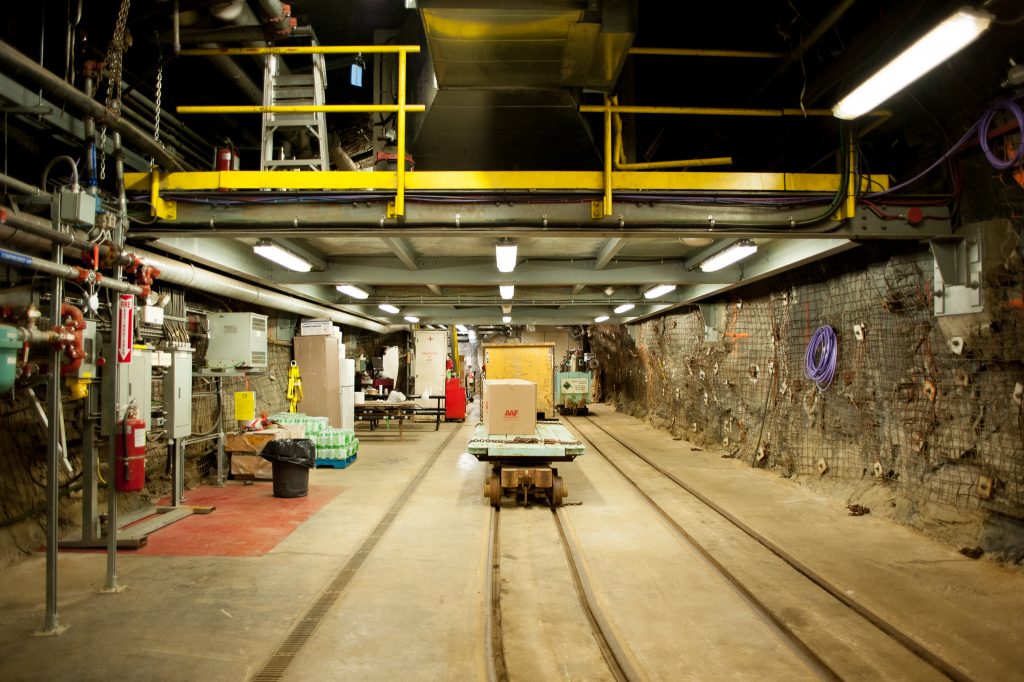
Entrance to the lab underground, looking towards the dirty side of the carwash: Every person who enters the lab on the other side must shower and change clothes. Every item that goes into the lab must go through the carwash. Photo: SNOLAB
At the end of this trek, a clean lab. Before entering, boots are washed at a special station. Clothes and boots are left on one side. People entering the clean lab strip, shower and dress with new clean garments on the other side of the shower to avoid contamination. A “lab responsible coordinator” checks that the lab is cleared for work — checking oxygen levels, among other parameters. It’s about an hour from the surface to beginning work, and the same — minus the shower — on the way back up. In a 10-hour day, this leaves about eight hours per shift to assemble the experiment.
A team of four, comprised of SNOLAB scientists and a technician, take turns and work in pairs to install. (No one can be alone underground, and there are restrictions on the maximum number of people to maintain physical distancing.)
“The packaging is very particular,” Tiffenberg said.
Every piece received must go through “the underground carwash,” Scorza said. Each item is triple-bagged and double-palleted to streamline the intricate process for unbagging and wiping materials before they can enter the cleanroom laboratory. On the other side of the carwash, the clean lab. For SENSEI, parts included pipe, cable, vessel, copper pieces for the inner side, cryogenics, layers of lead and copper shielding, and the bell jar.
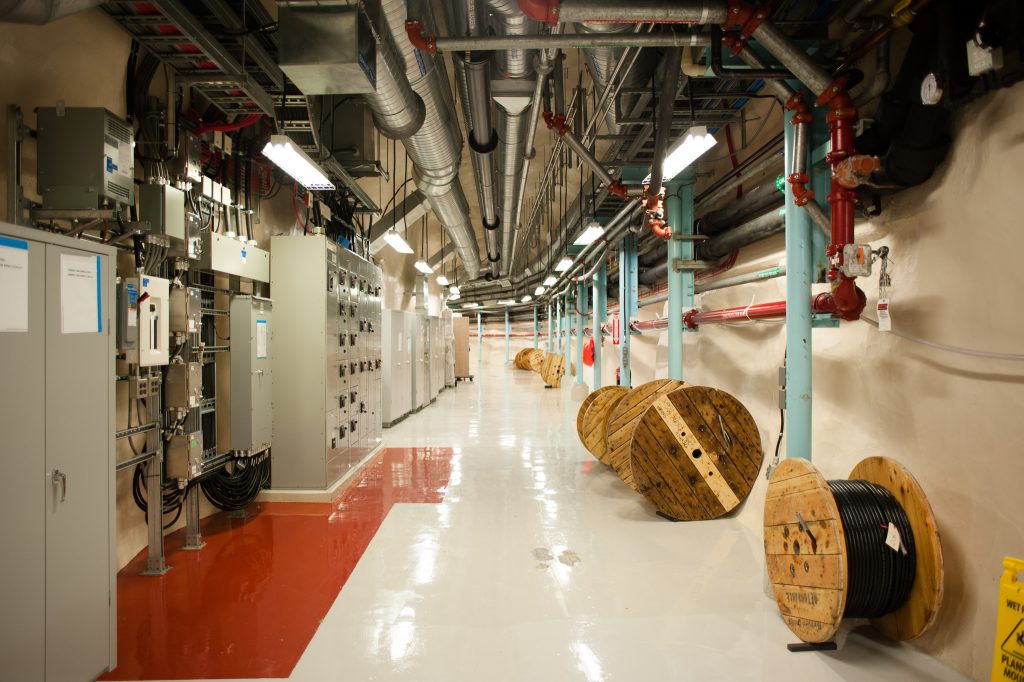
In stark contrast from the mine, on the other side of the carwash is the lab itself, an ultra clean facility. Photo: SNOLAB
“When these things were designed, of course, shipping everything assembled was not in the requirement list,” Tiffenberg said. “For the vast majority of things that we shipped, everything was perfectly fine.”
Only a few minor plastic pieces — easily replaceable — got loose and broke.
Once everything was opened and “looked good,” Tiffenberg said it was a “big, big relief.”
Installation began April 19 and was completed in late summer.
Though SNOLAB’s cleanroom is equipped with phones and Wi-Fi, communication outside of the documentation happens mainly in weekly meetings. The plan shifted from week to week, depending on whether the team could make it underground because of availability and COVID restrictions.
Some days it involved extreme care: touching those skipper CCDs. Others, it involved operating a crane to move lead shielding. Scorza said the mixture of work SNOLAB allows scientists to undertake — hands-on and analytical — gives them a more complete experience in experimental physics. “And, this is very fun. At least for me.”
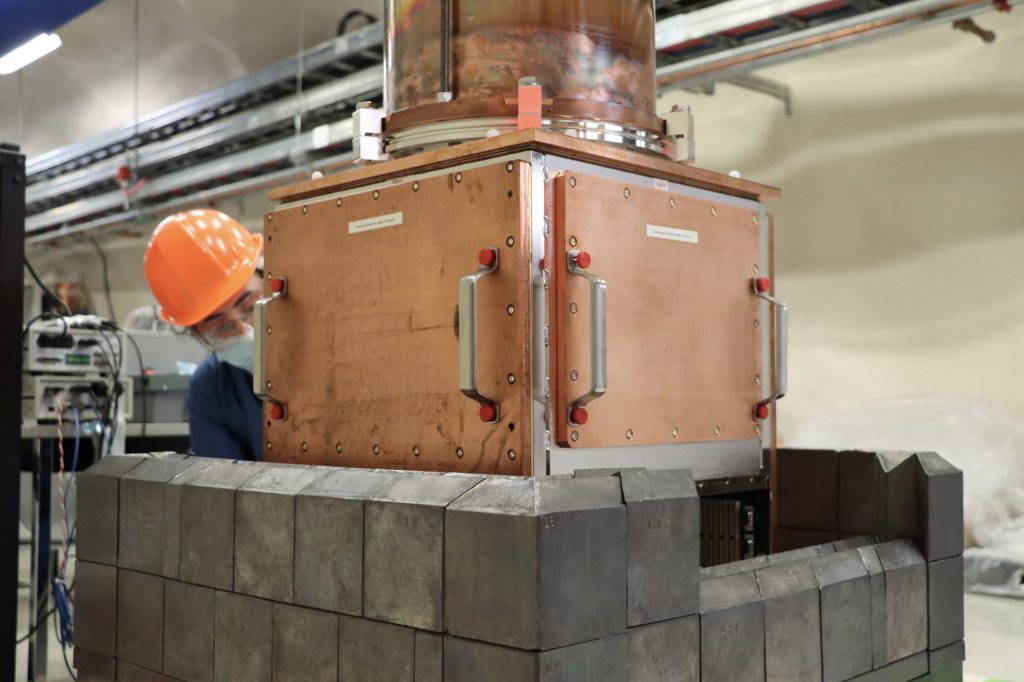
On Aug. 6, Steve Linden, a research scientist at SNOLAB, continues to assemble SENSEI in the underground cleanroom. Photo: SNOLAB
“I believe the fact that a team, a SNOLAB team of scientists, not originally very involved with the experiment, is able to progress with the underground installation shows that, first of all, physicists are very flexible,” Scorza said. “And (it’s) a testament to how robust the plan for this experiment is. Chapeau to the Fermilab team.”
Tiffenberg said he is grateful that the installation went by without any hiccups or surprises.
“It took a long time to get to this situation in which there are no surprises. At the beginning, everything felt, ‘Okay, we are spending a lot of time adjusting, coordinating, reviewing stuff.’ And that took a long time. But now that things are moving, that time that we took there we appreciate, because now everything is surprise-free.”
Though now that the experiment is taking data, a surprise in the form of a scientific discovery would be a nice reward.
Fermi National Accelerator Laboratory is supported by the Office of Science of the U.S. Department of Energy. The Office of Science is the single largest supporter of basic research in the physical sciences in the United States and is working to address some of the most pressing challenges of our time. For more information, please visit science.energy.gov.

